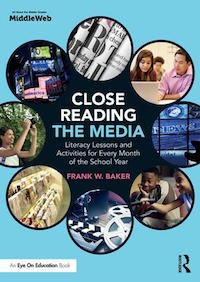SCROLL DOWN TO READ THE POST
Thinking with the Super Bowl
Here in Philadelphia, we’re particularly excited about this year’s Super Bowl. It’s a bit of a challenge to remember that a lot of learning that can happen beyond what happens on the field.
Each year, media literacy consultant Frank Baker reminds me that this major sports event is also particularly ripe for media literacy learning.
In a recent MiddleWeb post, he explains:
In 2018, Super Bowl 52 will be viewed by 100+ million people in the U.S. alone (NBC had an average audience of 111.9 million viewers in 2016) and the cost of a 30-second ad is estimated at $5 million this time around (about the same as 2017). At this stage of the run-up to the February 4th game, a lot of attention (on social media, in the press, and around the office water cooler) has already been given to the game and the commercials . . .
It’s up to us, as educators, to pull back the curtain on how these highly persuasive texts might pull an emotional string which makes us remember (or want to purchase) the product or spread the message.
TV and other video commercials should be considered as texts because they present information that students can learn to scrutinize closely (analyze) and deconstruct. In fact, the National Council of Teachers of English (NCTE) has long recommended that teachers include “non-print” texts in the classroom.
This year, Frank adds a Super Bowl Ad Analysis Worksheet to his Using Super Bowl Ads in the Classroom resource page, a website designed to help educators incorporate Super Bowl ads into instruction across the curriculum. Consider using this chart as a whole-class data collection tool, perhaps as a Google Form.
to his Using Super Bowl Ads in the Classroom resource page, a website designed to help educators incorporate Super Bowl ads into instruction across the curriculum. Consider using this chart as a whole-class data collection tool, perhaps as a Google Form.
ADVERTISEMENT
ADVERTISEMENT
Among my favorite resources on the site are the questions suggested in Close Reading of Media Texts for use before and after the game.
This coming week, for instance, you might consider some of Frank’s before kickoff questions:
- What do you know about the Super Bowl game? Where did you learn it?
- Why does the game get tremendous media attention every year?
- What makes advertisers want to put their ads on this once-a-year sporting event?
- Why does ad time cost $5 million for just one 30-second ad?
- Who decides what order the ads air during the game?
- How do advertisers create buzz about their ads, even before the game is broadcast?
- Create a chart listing the known advertisers and research their parent companies.
- How many ads are for: alcohol? cars? TV shows? movies? Why is this so?
- Which ad(s) are you looking forward to viewing and why?
- Which propaganda/persuasion techniques would you expect to be used in each ad?
- How do advertisers make money from their Super Bowl spots?
- Might you find ads inside/outside/above the stadium? If so, where?
Be on the lookout for not-so-obvious ads during the broadcast. (Students might want to create a list) - Based on the ads scheduled to be broadcast, what demographic (gender, age) do you think each advertiser is trying to reach?
- How was social media used, if at all, by advertisers before and during the game itself?
- How do you plan to use social media, it at all, during the game?
Don’t miss the collection of Super Bowl Ads Infographics that offer an immediate sense of the business stakes behind the big game. The analysis is not limited to this year’s ads. Frank links us to archives of ads from years past.
There’s also a fabulous gathering of lesson plans:
- Analyzing & Deconstructing A TV Commercial
- Persuasive Techniques in Advertising
- The Super Bowl Ads & Media Literacy
- Top 12 Super Bowl Activities for the Classroom
- 7 Super Bowl Lesson Plans/ Resources for the Classroom
- Media Literacy in Super Bowl Ads

Frank also leads us to the new USA Today AdMeter. This year, with free registration, USA Today encourages viewers/visitors to rate the 2018 Super Bowl ads. Some of the ads have already been posted and you’ll find USA Today’s gatherings of the most controversial Super Bowl ads of all time an d the funniest Super Bowl ads of all time.
d the funniest Super Bowl ads of all time.
Whether they are football fans or not, over the next couple of weeks we have an opportunity to authentically engage learners in understanding the media messages they face every day across their screens as informational text.
You may also be interested in Frank’s recent book Close Reading The Media, published by Routledge/MiddleWeb which I honored to review a few months back. You’ll find a calendar of creative and accessible ideas for using popular culture (including popular film, toy commercials, award shows, popular songs, news photographs, and MAD magazine cover parodies) in instruction.
Filed under: advertising, information literacy, media, media literacy, super bowl
About Joyce Valenza
Joyce is an Assistant Professor of Teaching at Rutgers University School of Information and Communication, a technology writer, speaker, blogger and learner. Follow her on Twitter: @joycevalenza
ADVERTISEMENT
SLJ Blog Network
One Star Review, Guess Who? (#202)
This Q&A is Going Exactly As Planned: A Talk with Tao Nyeu About Her Latest Book
More Geronimo Stilton Graphic Novels Coming from Papercutz | News
Take Five: LGBTQIA+ Middle Grade Novels
The Classroom Bookshelf is Moving
ADVERTISEMENT
ADVERTISEMENT







